Aisound 4.9手机版-产品白皮书
- 格式:pdf
- 大小:457.96 KB
- 文档页数:15
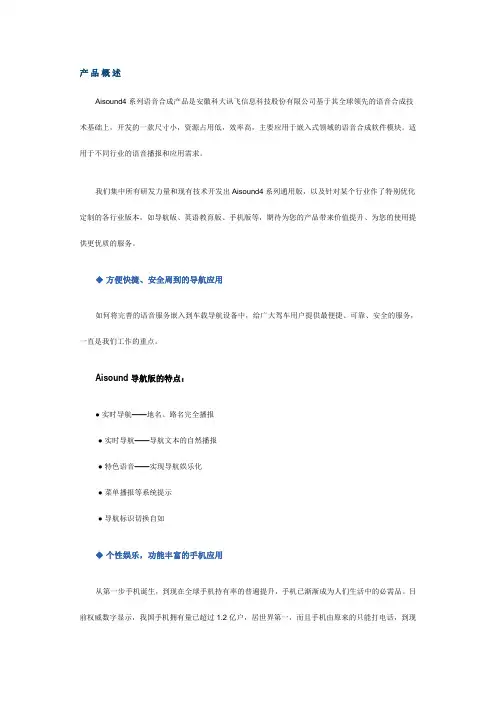
产品概述Aisound4系列语音合成产品是安徽科大讯飞信息科技股份有限公司基于其全球领先的语音合成技术基础上,开发的一款尺寸小,资源占用低,效率高,主要应用于嵌入式领域的语音合成软件模块。
适用于不同行业的语音播报和应用需求。
我们集中所有研发力量和现有技术开发出Aisound4系列通用版,以及针对某个行业作了特别优化定制的各行业版本,如导航版、英语教育版、手机版等,期待为您的产品带来价值提升、为您的使用提供更优质的服务。
◆方便快捷、安全周到的导航应用如何将完善的语音服务嵌入到车载导航设备中,给广大驾车用户提供最便捷、可靠、安全的服务,一直是我们工作的重点。
Aisound导航版的特点:●实时导航——地名、路名完全播报●实时导航——导航文本的自然播报●特色语音——实现导航娱乐化●菜单播报等系统提示●导航标识切换自如◆个性娱乐,功能丰富的手机应用从第一步手机诞生,到现在全球手机持有率的普遍提升,手机已渐渐成为人们生活中的必需品。
目前权威数字显示,我国手机拥有量已超过1.2亿户,居世界第一,而且手机由原来的只能打电话,到现在的丰富多彩的个性化功能,已经使得手机行业发展迅速,同时用户对手机功能和性能的要求也在逐步增强。
Aisound手机版主要应用:●小巧手机、强大语音——来电信息语音播报●短信播报●系统提示●屏幕操作语音播报●手机词典●手机导航●手机电子书◆准确、高效的英文教育应用目前英语教育已全面普及。
现在不管是学生升学,毕业后找工作,还是商务洽谈等,学习英语的作用和价值体现无处不在,全民学英语的动力也伴随着2008年北京奥运会达到了最高潮。
英语教育版应用:●即时词典——词条朗读●即时词典——解释、例句朗读●即时词典——音标朗读●即时翻译●系统提示●个性娱乐——语音电子书基本功能特性◆多种代码页、广泛文本范围,全面支持我们支持所有常见的代码页:UTF-16;UTF-8(CP65001);简体中文GB18030(CP936,兼容GB2312-80、GBK);繁体中文Big5(CP950,支持HKSCS);Phonetic Plain(金山词霸音标字体)。
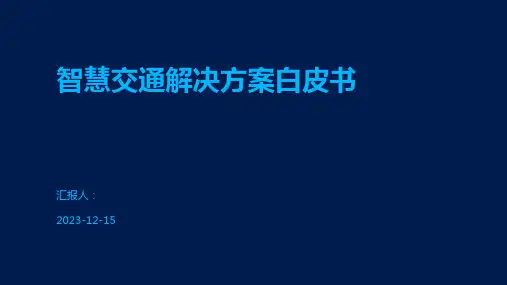
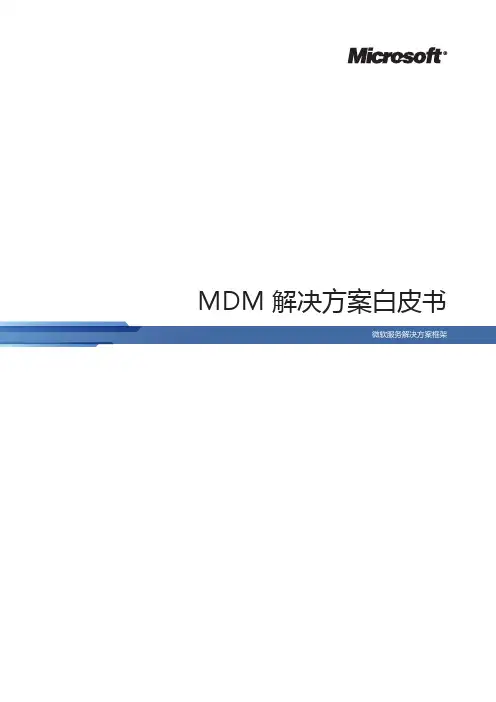
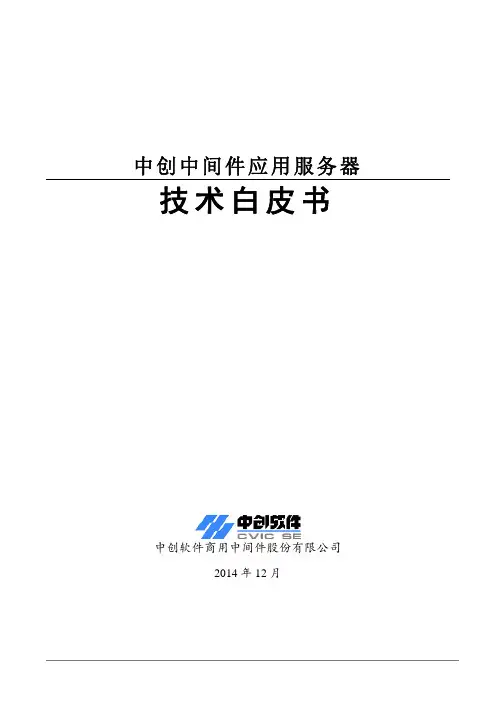
中创中间件应用服务器技术白皮书中创软件商用中间件股份有限公司2014年12月目录第1章市场概述 (3)1.1.核心价值 (3)1.2.市场需求 (4)第2章产品概述 (6)第3章产品组成架构 (8)3.1.体系结构 (8)3.2.容器 (9)3.2.1. Web容器 (9)3.2.2. EJB容器 (10)3.3.服务 (12)3.3.1. 会话管理(Session Management) (12)3.3.2. 连接器(Connector) (13)3.3.3. 名字服务(Naming Service) (14)3.3.4. 消息服务(Messaging Service) (16)3.3.5. JMX服务(JMX Service) (17)3.3.6. 邮件服务(JavaMail) (17)3.3.7. 事务服务(Transaction Service) (18)3.3.8. 安全服务(Security Service) (20)3.3.9. 数据源(DataSource) (21)3.3.10. 持久服务(Java Persistence) (22)3.3.11. RMI-IIOP (23)3.3.12.上下文依赖注入服务(Contexts and Dependency Injection) (23)3.3.13. Web服务(Web Services) (24)第4章产品特性 (26)4.1.灵活部署,快速构建 (26)4.2.统一管理,便捷运维 (26)4.3.全面监控,运筹帷幄 (26)4.4.高效集群,稳定可靠 (27)4.5.国产软硬件环境兼容,自主可控 (28)4.6.支持云计算,助力云迁移 (28)4.7.弹性架构,随需扩展 (29)4.8.W EB攻击防护,安全增值 (29)第5章综述 (31)5.1.产品优势 (31)5.2.市场应用 (31)第6章运行环境 (33)第7章支持的标准及规范 (35)第8章公司简介 (37)第9章成功案例 (38)第10章附录 A. 术语表 (40)第11章技术联系人 ......................................................................................................................... 错误!未定义书签。
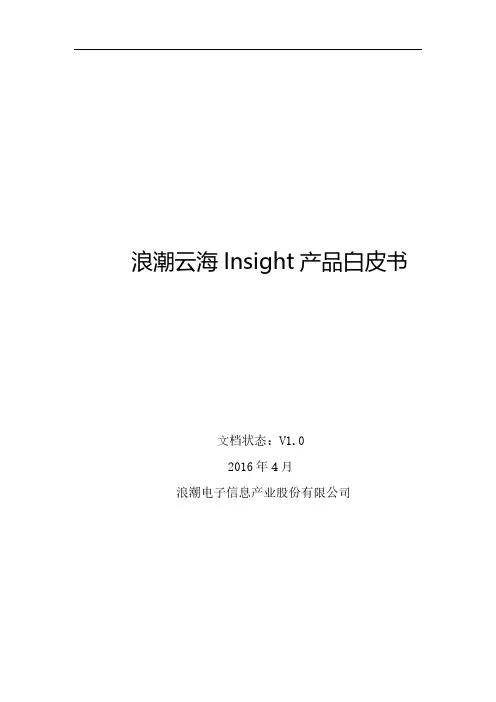
浪潮云海Insight产品白皮书文档状态:V1.02016年4月浪潮电子信息产业股份有限公司1产品功能云海Insight是包含分布式计算引擎HD(Hadoop发行版)、分布式并行数据库MPP和内存数据库MemDB等产品的产品族,提供从GB到PB级数据在高并发访问、数据查询和分析处理等不同应用场景大数据处理的能力,帮助客户轻松构建数据采集、数据存储、数据处理、数据应用开发的整个数据生命周期管理体系,快速搭建大数据处理平台。
云海Insight产品族包含分布式计算引擎HD、分布式并行数据库MPP和内存数据库MemDB:⏹分布式计算引擎HD是一个hadoop发行版,提供企业级的大数据处理环境,无缝集成了Hadoop生态中大量工具,提供海量数据存储、查询、分析和挖掘能力;⏹分布式并行数据库MPP是一个企业级的大规模并行处理关系型数据库,支持行存储和列存储,提供PB级别数据量的即席查询能力;⏹内存数据库MemDB是一个弹性伸缩的、提供事务支持的内存数据库,具备SQL读写能力,支持多地多中心级的广域网集群部署,用于构建和加速需要超高速数据交互的、具有高度可扩展能力的应用系统。
2产品规格3产品价值⏹快速实现多源数据整合,挖掘数据全新价值实现内外部信息资源的有效整合,全面提升数据共享和信息联动的运转效率,挖掘数据全新价值,支持决策管理。
⏹减少数据计算时间,提升业务效率具有并行处理架构、内存计算等多重机制,保证数据加载、计算、访问等各个环节数据处理效率最大化,提升业务效率。
⏹实现在线扩容,提升系统稳定性支持集群在线扩展,支持数据存储、加载和查询性能线性增长,并具备多层次的容错、自动检测和自动恢复机制,保证系统安全可用,降低业务停顿和运维风险。
⏹提供专业化咨询服务,提升服务质量浪潮具备丰富的大数据应用和行业落地实践经验,提供客户专业化的咨询服务,提升客户的服务质量。
4应用场景5典型案例某省警务云建设,汇集全省多源数据,为各警种部门上层应用提供数据服务,面临数据种类多且基数大、计算场景复杂、上层应用开发商多、业务需求多样等大数据处理的巨大挑战,仅靠单一技术无法满足需求。
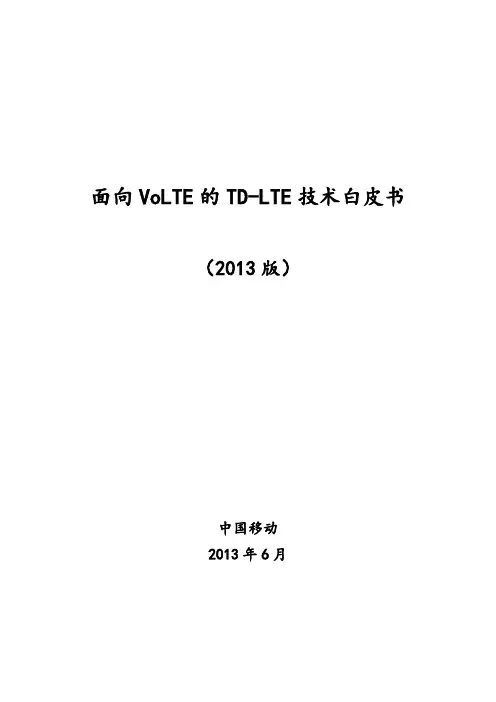
面向VoLTE的TD-LTE技术白皮书(2013版)中国移动2013年6月目录1.前言 (5)2.发展愿景 (5)3.面向VoLTE的TD-LTE相关要求 (6)3.1无线网络方面 (6)3.1.1多频段组网 (6)3.1.2连续及深度覆盖 (8)3.1.3基站建设 (9)3.1.4网络性能 (10)3.1.5语音及数据业务互操作 (11)3.1.6 TDD和FDD融合组网 (11)3.2核心网方面 (12)3.2.1 EPC融合核心网 (12)3.2.2 融合用户数据HLR/HSS (12)3.2.3 IMS支持VoLTE/eSRVCC (13)3.2.4 DRA信令网 (13)3.2.5 电路域支持eMSC (14)3.2.6 LTE回传方案 (14)3.2.7 LTE流量服务 (15)3.3终端方面 (16)3.3.1 多模多频段 (16)3.3.2 VoLTE手机总体要求 (16)3.3.3终端互操作要求 (18)3.3.4终端国漫业务要求 (19)3.3.5逐步支持LTE-A部分功能 (19)3.3.6 用户卡 (19)3.4国际漫游方面 (20)3.5运营方面 (20)3.5.1告警管理 (20)3.5.2 安全管理 (21)3.5.3系统升级 (22)3.5.4设备维护重点功能 (22)3.5.5网络自组织 (22)3.5.6 网管北向接口方案 (23)3.5.7 OMC重点功能要求 (24)3.5.8 MR数据要求 (24)3.5.9 信令软采功能要求 (25)4.结束语 (25)附录1:技术要求汇总 (26)附录2:缩略语表 (37)1.前言结合产业和市场发展,中国移动发布近两年面向VoLTE的TD-LTE 网络发展技术要求,涵盖TD-LTE网络建设、终端、业务、用户发展等方面所需的端到端主要技术要求1,旨在高效推进TD-LTE产业端到端设备开发以更好的契合中国移动TD-LTE发展需求。
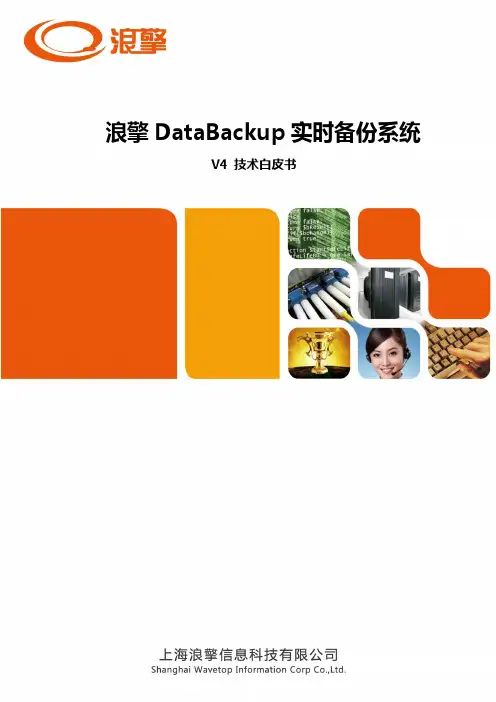
浪擎DataBackup实时备份系统V4 技术白皮书版权声明版权所有©2014上海浪擎信息科技有限公司未经本公司许可,任何单位或个人不得以任何形式,复制、传播、摘抄本内容的部分或全部。
本书内容上可能会有增删和修改,上海浪擎信息科技有限公司会定期将修订后的内容纳入新版本中,如有更改恕不另行通知。
公司申明浪擎科技是国内最大的备份容灾软件厂商,在备份容灾领域具备一流品牌影响力。
公司产品和解决方案分为D(数据级灾备)、A(应用级灾备)、Y(区域级云灾备平台)、S(备份存储柜)四大系列,涵盖了从桌面到服务器、从备份到容灾、从本地综合备份管理到异地数据中心建设等各个方面,构建完整的备份、容灾、存储解决方案。
浪擎科技已为众多高端用户建设了大型的灾备中心或灾备系统。
客户遍及政府、金融、医疗、能源、电信、媒体、制造、教育等各行各业,有超过10000家用户,承建了最多的区域级灾备中心建设案例。
所获成绩或荣誉:荣获2012年度上海科技小巨人;荣获2012年度全国电子政务十大IT创新品牌;荣获2012中国信息安全最具影响力企业奖;荣获2009年度科技部中小企业技术创新奖。
目录一、浪擎DataBackup实时备份 (5)1. 系统架构与部署 (5)2. Web管理平台 (6)二、主要应用系统的容灾 (7)3. 文件系统实时备份与容灾 (7)4. SQL Server实时备份与容灾 (8)5. Oracle实时备份与容灾 (9)6. MySQL实时备份与容灾 (9)7. Sybase实时备份/容灾 (10)8. DB2实时备份/容灾 (11)9. 通用数据类型实时备份与容灾 (12)三、数据定时备份 (12)10. 定时文件备份 (12)11. SQLServer定时备份 (13)12. 操作系统备份与裸机恢复 (13)13. VMWare虚拟机备份 (14)14. 三级索引存储模块 (14)15. 监控与报警模块 (15)16. 其他功能模块 (15)四、主要技术 (15)17. 实时数据捕获引擎打造实时备份 (16)18. 实时恢复实现业务容灾 (16)19. ACA保障实时备份的可靠性 (16)20. 差分合成ADA做到最快的恢复速度 (16)21. OOF实现备份数据网络流量最小 (17)22. 同一数据多实例运行实现大规模的并行化存储需求 (17)23. 操作系统、应用环境的裸机或异机恢复 (17)24. 重复数据删除 (18)25. 基于Web的统一管理和配置 (18)一、浪擎DataBackup实时备份浪擎D系DataBackup实时备份(以下简称实时备份) 4.1版对业务系统数据进行定时、实时在线备份,持续保护业务系统的数据。
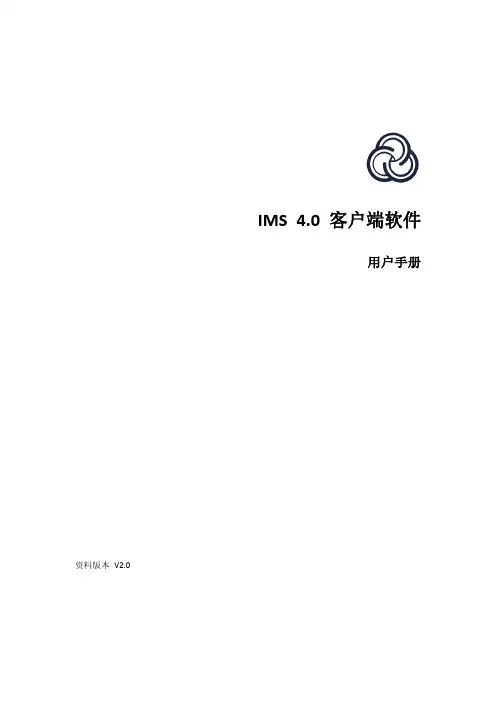
IMS4.0客户端软件用户手册资料版本V2.0前言本部分内容的目的是确保用户通过本手册能够正确使用产品,以避免操作中的危险或财产损失。
在使用此产品之前,请认真阅读产品手册并妥善保存以备日后参考。
适用产品本手册适用于网络视频监控软件IMS4.0。
本手册描述了网络视频监控软件的使用,指导您完成网络视频监控软件的配置与操作。
硬件建议配置CPU:Intel(R)Core(TM)i56500@2.6GHZ或以上型号内存:4G或更高显卡:Intel HD630以上集成显卡或NVIDIA GTX750以上独立显卡网卡:千兆网卡或以上光驱:DVR-R硬盘:250G或以上,保证20G可用空间交换机:千兆交换机或以上软件要求1)windows764位系统、windows864位系统、windows1064位系统(不支持XP系统)2)Microsoft Visual C++2015X86Redistribuable Setup3)Microsoft Visual C++2015X64Redistribuable Setup系统环境程序运行需要占用554端口、11100端口、11110端口、11112端口、11114端口、11116端口、11118端口、11120端口、11122端口及11111端口,一台PC只能运行一个数据库,请确保没有其他数据库正在运行且这些数据端口未被占用,否则可能会导致程序无法正常运行。
目录IMS4.0客户端软件 (1)用户手册 (1)软件要求 (2)系统环境 (2)第一章安装和启动软件 (5)第二章设备管理 (6)2.1.添加区域 (6)2.2.修改区域 (7)2.3.删除区域 (8)2.4.搜索设备 (8)2.5.手动添加 (10)2.6.编辑设备 (11)2.7.删除设备 (11)第三章人员管理 (13)3.1.添加部门 (13)3.2.编辑部门 (14)3.3.删除部门 (15)3.4.添加人员 (16)3.5.编辑人员 (17)3.6.删除人员 (18)1.单人删除 (18)2.批量删除 (19)3.7.移动人员 (19)3.8.导入导出 (20)1批量导入 (20)2批量导出 (21)3.9.自定义属性 (21)第四章人员分配 (24)4.1.权限组管理 (24)4.2.设备管理 (24)4.3.人员管理 (26)第五章实时预览 (27)5.1.通道预览 (27)5.1.1.开启预览 (27)5.1.2.关闭预览 (29)5.2.布局轮巡 (31)5.3.通道对讲 (32)5.4.云台 (33)5.5.预览控制 (35)5.5.1.播放比例 (35)5.5.2.智能帧 (35)5.5.3.分屏 (36)5.5.4.抓拍 (38)5.5.5.全屏 (38)5.5.6.预览音频 (38)第六章录像回放 (39)6.1.录像计划 (39)6.2.录像查询 (39)6.3.录像播放及控制 (41)6.4.录像下载 (41)第七章人脸应用 (43)7.1.预览 (43)7.2.常规记录 (44)7.2.1.抓拍记录 (44)7.2.2.识别记录 (45)7.3.以图搜图 (46)第八章考勤管理 (47)8.1.基本规则 (47)8.2.考勤点管理 (48)8.3.班次管理 (48)8.4.考勤组管理 (50)8.5.节假日管理 (51)8.6.报表 (52)8.6.1.每日统计 (52)8.6.2.阶段汇总 (53)8.6.3.原始记录 (54)8.6.4.补卡记录 (55)第九章存储服务器 (57)9.1.服务器管理 (57)9.2.配额管理 (58)9.3.通道配置 (58)9.4.模板设置 (60)第十章用户管理 (61)第十一章联动规则 (62)11.1.事件类型 (62)11.2.联动动作 (63)第十二章事件中心 (65)12.1.实时告警 (65)12.2.事件查询 (66)第十三章日志管理 (68)第十四章系统设置 (69)14.1.功能配置 (69)14.2.声音配置 (69)14.3.图片路径 (70)第一章安装和启动软件操作步骤:(1)双击.exe安装文件,按向导完成安装。

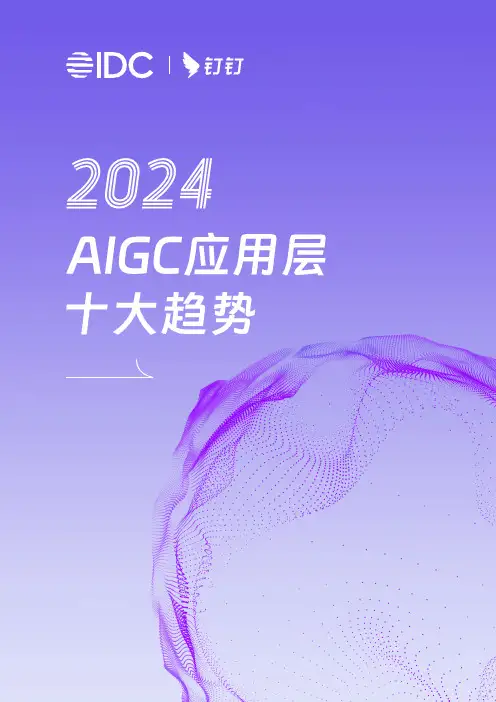
序言一、AIGC技术进步推动产业变革二、����年AIGC应用层十大预测趋势一:应用层创新成为���� AIGC产业发展的确定方向趋势二:大模型从“赶时髦”到“真有用”,成为提效手段趋势三:专属、自建模型将在中大型企业涌现趋势四:多模态大模型塑造“多边形战士”应用趋势五: AI Agent是大模型落地业务场景的主流形式趋势六:AIGC加速超级入口的形成趋势七:业务流程迈向“无感智能”趋势八:应用从云原生走向AI原生趋势九:AIGC逐步普惠化趋势十:智能涌现是把双刃剑,需要与之匹配的安全措施三、IDC 建议�.� 对终端用户�.� 对生态开发企业四、关于钉钉�.� 钉钉产品的价值主张、创新性�.� 产品解决方案��������������������������������������CONTENTS邬贺铨 中国工程院院士我国正在经历经济发展的重要时刻,以生成式人工智能等为代表的智能经济活动逆势增长,成为我国推动经济持续增长、构筑科技创新和产业升级之基,也成为支撑经济体系现代化的新引擎。
工业和信息化部的统计数据显示,�-��月份,我国软件和信息服务业务收入�����亿元,同比增长��.�%。
整个行业的增长率要远高于同期GDP的增长率。
大模型、AIGC是当前全球数字经济发展的热点和趋势,也是人工智能重要的核心技术。
各类科技大公司、创新型公司展开投入竞赛。
然而人们往往低估新技术的长期影响力,面对AIGC技术,我们既要抓住机遇立即行动,也要为人工智能的长跑做长期打算,从长布局。
AIGC的应用落地对于推动我国人工智能产业快速、持续、健康发展具有非常重要的作用。
融入企业运营、紧贴应用场景,解决应用落地的最后一公里,才能真正发挥大模型、AIGC等新技术、新产品的作用,实现整个AI产业链和生态的繁荣。
大模型、AIGC的应用落地也将创新产业生态模式,MaaS、PaaS将成为智能经济时代的重要业态。
目前已有的基础大模型很难直接应用于各行业领域,企业需要结合自身的行业特点和专业知识,研发出可嵌入MaaS和PaaS的适合企业自身的行业大模型、专属大模型或场景大模型。
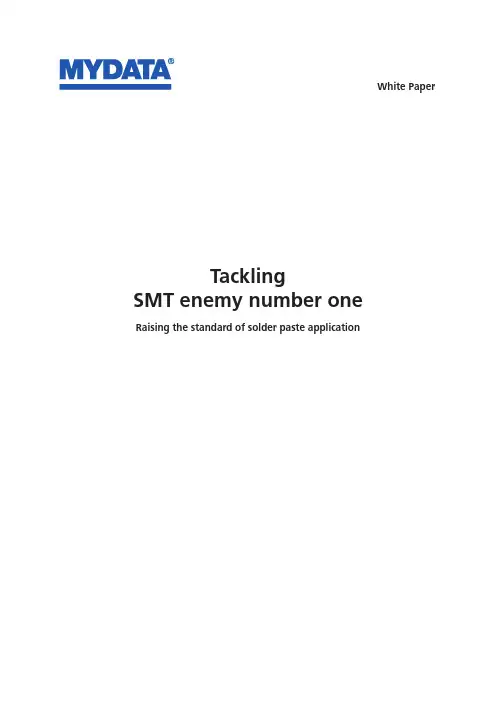
White PaperTacklingSMT enemy number oneRaising the standard of solder paste applicationIs screen printing technology able to keep pace with rising quality demands and increasingly complex board layouts?Or, is new jet printing technology ready to fill the gap? A comparison study between the two methods reveals some interesting differences. Screen printers offer some possibilities for optimizing solder paste deposits, but optimization is far easier and quicker with the jet printer. At the same time, the ability to print individualized deposits on every single pcb pad may be the ultimate answer to the growing quality challenge.A challenging futureThe role of the solder joint is all important in ensuring the final quality of any printed circuit board assembly. As well as providing a robust electrical interconnection it also needs to ensure a reliable mechani-cal interconnection. The application of solder paste is key to ensuring high quality solder joints but it is affected by a great many parameters. Currently, printing issues are the most commonly cited cause of error during the surface mount assembly process and account for some-thing like 70% of all soldering errors – mainly opens, insufficients and bridges.Industry trends are making the situation ever more challenging. Boards are becoming denser, use smaller and finer pitch components and require small and large components to be placed very close to-gether. Modern manufacturers are faced with more complex produc-tion, higher quality demands and the need to maximize automation in order to improve efficiency and to remain price competitive. In today’s ultra-competitive environment there is no longer any place for errors! Automated screen printingScreen printing with a squeegee blade and metal foil stencil represents the standard method of depositing solder paste in surface mount as-sembly operations. Despite advances in automation and increasingly sophisticated solutions stencil printing remains a key area of concern. What causes that concern is the sensitivity of the printing process and the fact that so many parameters contribute to the final result. Pa-rameters include: printing speed; squeegee type; angle and pressure; gasketing between the stencil and pcb; separation speed; underside wiping of the stencil; pcb support (especially for second-side printing); and stencil thickness and aperture design. Each of these parameters needs to be carefully optimized to ensure quality. And a new set of parameters needs to be assigned for each new job that is undertaken.One of the limitations of stencil screen printing is the fact that the volume deposited is, to a large extent, determined by stencil thickness. While stepped stencils go some way to overcoming this issue they also add further costs and complexity. They also mean certain restrictions are imposed on pcb design in order to maintain ‘keep-out distances’ (the distance required between an aperture in a ‘stepped’ area and the nearest ‘normal’ area).By far the most common situation is for manufacturers to use regular metal foil stencils in their production.Automated jet printingAutomated jet printing is a relatively new technique that uses a unique ejector mechanism to deposit solder paste onto printed circuit boards at high speed. The non contact printing technology applies no force to the pcb and builds up solder paste deposits in three dimen-sions (i.e. solder paste droplets can be deposited on top of each other). The process is completely software controlled and default settings are provided for each component based on CAD data. However, the user has the freedom to fine-tune the volume, area coverage, height and layers of solder paste for each individual pad, component or package.The stencil-free technology provides much faster response times com-pared to screen printing. There is no lost time ordering, waiting for or cleaning stencils and, as print programs are prepared off-line, setup and changeover times are also minimized. In addition, layout changes or print adjustments are extremely quick and simple to implement. Fully automated jet printing technology has been developed by MYDATA automation AB, Sweden. The first jet printer (MY500) was launched in 2007 and a new generation of the product was introduced in 2008.So, how does the quality of the jet printer stand up compared to screen printing in a real life production environment?Head-to-head study using live production boardsA study to compare the two technologies was carried out at a major European electronics contract manufacturer. The company is a leader in high-tech electronics production and is ISO 9001-2000 & 14001, AQAP 2120-2003, IEC 61508 and TL 9000 certified, with customers coming from the worlds of healthcare, telecommunications, aviation and defence.The study lasted for one week, measuring solder paste deposits on customer boards that were produced as part of the company’s stan-dard operations. 12 batches were included in the study with approxi-mately 14 boards per batch. Half of each batch was run on a screen printer and the other half on the jet printer. (Note, two of the batches were run on the jet printer only.) Three different MPM screen printerswere used along with three different stencil thicknesses.An example of one of the customerboard layouts that was used in the study.Breakdown of boards produced during the study. (Note, where necessary, results from the study were weighted in order to compensate for different pcb quantities within certain batches.)After printing, the boards were taken off-line and inspected using a Koh Young Technology three dimensional solder paste volumemeasurement instrument. All measurements were carried out on site, after which the boards were placed back into the production process. The manufacturer also carried out its usual production and quality checks, both prior to and after component assembly, according to its own stringent quality control processes.The study generated measurements from more than 100,000 solder paste deposits. Analysis of the results focused on five key attributes of solder paste application: Overall Quality; Volumes; Repeatability; Predictability; and Accuracy.Overall Quality – Good to go!As would be expected from a competent and reliable manufacturer, all of the boards were of a high quality. The manufacturer’s stringent quality control processes, based on IPC standards, were followed and any minor errors were picked up and corrected as part of the normal production process. As such, all boards received quality approval and were delivered to their respective customers.So, if all boards were of acceptable quality, what, if any, were the differences between the two printing methods?Koh Young Technology is a world leader in 3-D measurement and inspection, offering 100% 3-D Paste Measurement based on the patented Shadow-Freemeasurement technology .Volume – Compromise versus individualizeProbably the main difference between the two technologies was in terms of the volumes of solder paste deposited. Screen printing with a standard stencil always requires a compromise between the smaller components that need less paste and the larger ones that need more. The tendency is to choose stencil thickness based on the needs of key components. At the same time it is important to ensure that there is always enough paste on every pad to avoid insufficients or open joints. Invariably, this means that more paste is applied than is neces-sarily needed.Jet printing, on the other hand, allows volumes to be individualized for every single pad. This means that solder paste application can be optimized for each component and there is never any need to apply more paste than necessary.The difference can be seen in the study results which showed that for all batches the jet printer used less volume. For one particular board the jet printer required just 55% of the paste volume that the screen printer required. Comparing the average volume across all ten differ-ent boards, the jet printer required 65% of the paste volume that the screen printers required.50000010000001500000200000025000003000000Stencil JetSOLDER PASTE VOLUME (nanoliter, nl)A comparison of the total solder paste volume used for printing each batch. On average the jet printer used just 65% of the volume that the screen printers used.In addition to volume, jet printing also allows printing patterns to be individualized on every pad. Users have the flexibility to adjust the size, position, pattern and height of solder paste. This means deposits can be optimized in order to avoid joint errors or enhance joint functional-ity. For example, allowing total freedom of heatsink deposit design, ensuring good wetting through proper pad coverage, or allowing triangle-shaped deposits in order to avoid mid ship solder balls.With each technology being used to produce 70 boards, total volumes translated into 83g of solder paste used by the screen printers and 54g used by the jet printer. However, this does not take into account the additional paste consumed when screen printing, i.e. through spill-ages and cleaning etc., which the jet printer avoids through the use of solder paste cassettes that simply snap into place.Repeatability – Achieving the same results timeand time againLooking at solder paste volumes for specific components across all batches raised an interesting difference between the two technologies. For key components, such as fine-pitch BGAs and QFPs, the results for the two methods were very similar. When screen printing, it is likely that these types of difficult components determine the choice of stencil thickness, thereby, ensuring consistent results. In fact, when consider-ing all components overall, the technologies achieved relatively similar results – even though standard deviation with the jet printer was lower for 10 out of the 12 batches.The two technologies achieved similar repeatability results for key components such as BGAs.Volume [nl]FrequencyHistogram of Volume [nl]Example of triangle-shaped deposits achieved with the jet printer.However, when it came to some of the smaller components, the screen printers showed less consistency. For example, the histogram for 0603s included three peaks, while the one for 0805s had two distinctive peaks. The explanation for this is that these components were included in dif-ferent batches that used stencils of different thicknesses, i.e. the optimal volumes for these chips were compromised in order to meet the optimal requirements of other components on the same board.With the jet printer it does not matter what the component mix on a board is as volumes are always optimized for each individual com-ponent. So, even with the small components, the jet printer achievedconsistent results for repeatability across all batches.For 0603s three separate peaksare clearly discernable when screen printing with three different stencil thicknesses, while jet printing achieved very consistent results or this component.The screen printers produced rather inconsistent results for 0805s. The optimal volume for this component have been compromised by the use of two different stencil thicknesses.Predictability – Does theory match reality?When comparing the actual volume of solder paste used to the amount expected to be used, the screen printer results were reasonably accu-rate, despite the many parameters involved.The jet printer, on the other hand, achieved truly excellent results with the actual volume being extremely close to the nominal value. Several factors contribute to this including the fact that there is less operator intervention with the jet printer, i.e. volumes are set during programming, after which solder paste feeding is completely software controlled. It is also a closed system, so all of the paste jetted ends up on the pcb. In addition, as jetting is a non contact technique it is not affected by warped boards.In the case of screen printing, both manual and technical issues affect the actual amount of solder paste used. For example, stencil quality, pcb support, squeegee pressure and the solder mask can all affect printing volumes. Also, paste is prone to sticking in apertures when the stencil is lifted, particularly with fine pitch applications. More frequent cleaning of stencils and/or vibrating stencils prior to lifting may be necessary, with the associated risks of manual adjustments and errors.The expected volume required by the jet printer matched the actual volume used extremely closely.NOMINAL VOLUME JETVOLUME JETALL TEST SERIESACTUAL/ NOMINAL VOLUMEAccuracy – Hitting the right spotDeposit accuracy is obviously important in order to ensure good solder joint quality. In the production study the two technologies achieved very similar results.The non contact principle, along with the use of board fiducials (refer-ence markers on the pcb used by the jet printer’s imaging system), mean that the accuracy of the jet printer is not affected by aspects of board quality. Accuracy is the result of software-controlled x-y move-ments of the jetting mechanism.Screen printing accuracy, on the other hand, is directly affected by pcb or panel quality, including how the board is cut, stretching, warpage and solder mask quality etc. Furthermore, stencil quality and stencil alignment are two additional parameters that are very important in determining screen printing accuracy.Copyright MYDATA automation © 2009 11Tackling SMT enemy number one – Raising the standard of solder paste applicationWhite paper - Rev. 1ConclusionsEach component type has its own individual characteristics such as leadgeometry, land pattern and weight that set different requirements forsolder paste deposits. Achieving the correct solder paste volume andcoverage per pad is essential for high quality solder joints across the pcb.While screen printing using metal foil stencils has served the electron-ics industry well, it remains a cause for concern. As shown in this study,it is possible to achieve good quality screen printing, although certaincompromises are always necessary. Also, due to the many parametersinvolved, optimizing conditions for a specific job can be very timeconsuming and requires a good deal of operator experience. As withany process, the more parameters and steps involved the harder it is toensure consistency. At the same time, the more operator involvementthere is, the higher the chance of introducing errors.In contrast, MYDATA’s MY500 jet printer is a touchless, closed systemthat greatly reduces the number of parameters involved. As illustratedin the live production study, the jet printer matched or bettered thehigh quality screen printing in all aspects.With full software control the jet printer allows far greater scope foroptimizing solder paste application. Operators have complete flexibilityto fine-tune the volume, area, pattern, height and layers of solder pastefor every individual pad, component or package on the pcb.Having easy access to this level of control and flexibility is likely tobecome increasingly desirable to manufacturers as the industry contin-ues to turn to smaller and finer pitch components on denser, high mixboards.。
InCloud Sphere 4.5 旗舰版技术白皮书V1.0浪潮(北京)电子信息产品有限公司2017 年 1 月InCloud Sphere 4.5 旗舰版技术白皮书 V1.0目录1第一章摘要 (5)2第二章InCloud Sphere 产品概述 (6)2.1InCloud Sphere 介绍 (6)2.2InCloud Sphere 架构 (8)3第三章InCloud Sphere 技术原理 (9)3.1InCloud Sphere 系统设计 (9)3.2InCloud Sphere 核心技术 (11)3.2.1CPU 虚拟化 (13)3.2.2内存虚拟化 (15)3.2.3I/O 设备虚拟化 (17)4第四章InCloud Sphere 功能原理 (19)4.1 计算 (19)4.1.1CPU 管理 (19)4.1.2内存管理 (19)4.1.3GPU 管理 (20)4.2 存储 (23)4.2.1 存储I/O (23)4.2.2 快照 (24)4.2.3存储多路径 (25)4.2.4存储读缓存技术 (26)4.3 网络 (26)4.3.1网络虚拟化架构 (26)4.3.2网卡绑定 (29)4.3.3QOS (33)4.4高可用 (33)4.4.1vMotion (33)4.4.2Storage vMotion (36)4.4.3 HA (38)4.5负载均衡 (41)4.6 监控 (44)4.6.1性能收集 (45)4.6.2配置性能图表 (46)4.6.3自动化告警机制 (46)4.7vApp (48)4.8 灾备 (49)4.8.1DR 结构 (49)4.8.2DR 工作原理 (50)4.8.3DR 故障转移 (50)4.8.4备份机制 (51)4.9 容器 (52)4.9.1Docker 介绍 (52)4.9.2InCloud Sphere 旗舰版和Docker (52)4.9.3InCloud Sphere 提供Docker 支持优势 (54)5第五章InCloud Sphere 自动化能力 (56)5.1自动化安装 (56)5.1.1自动化部署架构 (56)5.1.2自动化部署条件 (56)5.1.3自动化部署过程 (57)5.1.4应答文件 (57)5.2自动化更新 (57)5.2.1iCenter 自动检查可用更新 (57)5.2.2Hotfix 自动更新 (58)5.2.3InCloud Sphere Tools 自动更新 (59)5.2.4池滚动升级 (59)6第六章InCloud Sphere 开放性和安全性 (61)6.1XAPI (61)6.1.1XAPI 介绍 (61)6.1.2XAPI 功能 (62)6.1.3XAPI 架构 (62)6.2Introspect API (63)6.2.1Introspect API 介绍 (63)6.2.2虚拟机内存保护 (63)6.2.3预防攻击技术 (63)6.2.4虚拟机无代理保护 (64)6.2.5Direct Inspect API 防病毒架构 (64)6.2.6Direct Inspect API 防病毒的优势 (65)6.3PlugIn (65)6.3.1PlugIn 介绍 (65)6.3.2PlugIn 优势 (66)6.3.3部分PlugIn 插件列表 (66)6.4安全架构 (66)6.5SSR (67)6.5.1SSR 介绍 (67)6.5.2SSR 实现原理 (68)6.5.3SSR 技术架构 (69)6.5.4SSR 主要功能 (70)6.6与OpenStack 集成 (70)6.6.1OpenStack 介绍 (70)6.6.2InCloud Sphere 旗舰版的优势 (70)6.6.3与OpenStack 集成架构图 (71)7第七章总结 (73)8第八章缩略语 (74)1第一章摘要浪潮,着力推动中国“行业云”,致力于成为中国领先的云计算解决方案供应商,业已形成涵盖IaaS、PaaS、SaaS 三个层面的整体解决方案服务能力。
中国移动5G商用手机产品白皮书(2 020 年版)2019 年11月目录1.前言 (5)2.相关背景 (5)2.1.技术发展 (5)2.2.网络建设 (6)2.3.产业合作 (6)3.5G 终端发展策略 (7)4.5G 终端产品要求 (8)4.1.无线通信要求 (8)4.1.1.NSA/SA 要求 (8)4.1.2.模式要求 (8)4.1.3.频段要求 (9)4.1.4.语音方案要求 (9)4.1.5.版本要求 (10)4.1.6.支持SA 模式的终端功能要求 (10)4.1.6.1.NR 模式功能要求 (10)4.1.6.2.其它模式功能要求 (11)4.1.7.支持NSA 模式的终端功能要求 (11)4.1.7.1.EN-DC 组合功能要求 (11)4.1.7.2.其它模式功能要求 (12)4.1.8.NR 模式其它要求 (12)4.1.9.LTE ONLY 模式 (13)4.1.10.紧急呼叫 (13)4.1.11.短信业务 (13)4.1.12.网络切片要求 (13)4.1.13.IP 协议栈要求 (14)4.2.性能要求 (14)4.2.1.NR 模式速率要求 (14)4.2.2.时延要求 (14)4.3.硬件体验要求 (15)4.3.1.WLAN 功能要求 (15)4.3.2.机卡相关要求 (15)4.3.3.NFC 功能要求 (16)4.4.软件体验要求 (16)4.4.1.终端管理要求 (16)4.4.2.视频彩铃要求 (16)4.4.3. 5G 开关 (16)4.4.4.信号显示要求 (16)4.4.5.API 要求 (17)4.5.业务及应用要求 (17)4.6.安全能力等级要求 (17)4.7.质量要求 (17)4.7.1.协议/射频要求 (18)4.7.2.多网络端到端兼容性要求 (18)4.7.3.关键通信性能要求 (18)4.7.4.天线性能 (18)4.7.5.续航及功耗要求 (19)4.7.6.发热要求 (19)4.7.7.稳定性要求 (19)5.产品标识要求 (19)结束语 (20)附录2:终端的工作频段 (21)附录3:引用技术规范汇总 (22)附录4:版本更新记录 (22)1.前言2019 年6 月6 日,中国移动获得第五代移动通信业务牌照,2019 年10 月31 日,中国移动宣布 5G 商用,正式迈入 5G 商用时代。
一、前言
随着移动互联网技术的发展,在2024年会出现更加发达的移动互联
网技术,为消费者提供更优质的服务。
移动互联网可以满足消费者的需求,让他们随时随地想要什么就可以获得什么,更好地满足他们的日常需求,
从而增强用户体验。
本白皮书将详细介绍移动互联网在2024年发展的趋势。
二、移动互联网技术
1、5G无线网络
2024年,5G无线网络将成为移动互联网发展的重要基础,提供更大
的带宽、更快的网络速度、更安全的信息传输以及更低的延迟等功能。
2、智能语音技术
智能语音识别技术可以让用户更轻松的与智能设备进行交流,具有中
文语音识别、国际语音识别等功能,以及更友好的用户体验,处理复杂的
任务,可以为智能家居、智能安全和社交、电子商务等提供更优质的服务。
3、虚拟现实技术
2024年,虚拟现实技术将得到进一步发展,可以为消费者提供更多
有趣的体验。
它支持多种形式的虚拟现实体验,更好地满足移动互联网的
消费者需求,可以更加有效地推动消费者行为,提高消费者的购买满意度。
4、跨屏技术
2024年,跨屏技术将获得进一步发展。
语音识别技术白皮书摘要本白皮书旨在介绍语音识别技术的发展现状、应用领域以及未来发展趋势。
语音识别技术作为人机交互的重要手段,在智能手机、智能音箱、智能车载等领域有广泛应用。
本文将从技术原理、应用场景、挑战与解决方案以及未来发展等方面进行探讨。
1. 引言语音识别技术是一种将语音信号转化为文字的技术,它通过分析语音信号的频谱、时域特征等来识别语音中的文字内容。
随着人工智能技术的不断发展,语音识别技术在人机交互领域扮演着越来越重要的角色。
2. 技术原理语音识别技术的核心是声学模型、语言模型和解码器。
声学模型用于将语音信号转化为音素序列,语言模型用于根据上下文信息对音素序列进行修正,解码器则用于将修正后的音素序列转化为文字。
3. 应用场景语音识别技术广泛应用于智能手机、智能音箱、智能车载等领域。
在智能手机上,语音助手可以通过语音识别技术实现语音搜索、语音输入等功能。
在智能音箱上,语音识别技术可以实现语音控制家居设备、播放音乐等功能。
在智能车载领域,语音识别技术可以实现语音导航、语音拨打电话等功能。
4. 挑战与解决方案语音识别技术面临着语音多样性、噪声干扰、语音识别错误率等挑战。
为了解决这些挑战,研究人员提出了多种解决方案,如深度学习模型、大规模训练数据集、声学模型和语言模型的优化等。
5. 未来发展趋势未来,语音识别技术将继续向更高的准确率、更低的错误率发展。
同时,随着人工智能技术的发展,语音识别技术将与自然语言处理、机器学习等技术相结合,实现更加智能化的语音交互体验。
此外,语音识别技术还有望在医疗、教育、安防等领域得到更广泛的应用。
结论语音识别技术作为一种重要的人机交互手段,在智能设备领域有着广泛的应用前景。
随着技术的不断进步和创新,语音识别技术将在未来实现更高的准确率和更广泛的应用。
我们期待语音识别技术能够为人们的生活带来更多的便利和创新。
重要声明版权声明版权所有 © 2008, 安徽科大讯飞信息科技股份有限公司,保留所有权利。
商标声明安徽科大讯飞信息科技股份有限公司的产品是安徽科大讯飞信息科技股份有限公司专有。
在提及其他公司及其产品时将使用各自公司所拥有的商标,这种使用的目的仅限于引用。
本文档可能涉及安徽科大讯飞信息科技股份有限公司的专利(或正在申请的专利)、商标、版权或其他知识产权,除非得到安徽科大讯飞信息科技股份有限公司的明确书面许可协议,本文档不授予使用这些专利(或正在申请的专利)、商标、版权或其他知识产权的任何许可协议。
不作保证声明安徽科大讯飞信息科技股份有限公司不对此文档中的任何内容作任何明示或暗示的陈述或保证,而且不对特定目的的适销性及适用性或者任何间接、特殊或连带的损失承担任何责任。
本手册内容若有变动,恕不另行通知。
本手册例子中所用的公司、人名和数据若非特别声明,均属虚构。
未得到安徽科大讯飞信息科技股份有限公司明确的书面许可,不得为任何目的、以任何形式或手段(电子的或机械的)复制或传播手册的任何部分。
保密声明本文档(包括任何附件)包含的信息是保密信息。
接收人了解其获得的本文档是保密的,除用于规定的目的外不得用于任何目的,也不得将本文档泄露给任何第三方。
本软件产品受最终用户许可协议(EULA)中所述条款和条件的约束,该协议位于产品文档和/或软件产品的联机文档中,使用本产品,表明您已阅读并接受了EULA的条款。
版权所有© 安徽科大讯飞信息科技股份有限公司Copyrights © Anhui USTC iFLYTEK CO., LTD.目录前言 (1)1产品应用概述 (2)1.1小巧手机,强大语音——来电信息语音播报 (2)1.2小巧手机,强大语音——短信语音播报 (2)1.3小巧手机,强大语音——屏幕操作语音播报 (3)1.4系统提示 (3)1.5手机词典 (3)1.6手机导航 (3)1.7手机电子书 (4)2功能特性 (5)2.1多种代码页、广泛文本范围,全面支持 (5)2.1.1支持代码页 (5)2.1.2文本朗读范围 (5)2.2强大的智能处理能力,语随文动 (5)2.2.1数字和号码处理 (5)2.2.2多音字处理 (6)2.2.3常见符号处理 (6)2.2.4灵活标注 (6)2.3多语种多发音人,多选择、更丰富 (7)2.3.1语种 (7)2.3.2发音人 (7)2.3.3中英混读 (7)2.4兼容平台广泛,适应性强 (7)2.4.1完全与平台无关 (7)2.4.2资源占用低 (8)2.4.3资源放在存储卡上,仍可正常运行 (8)2.4.4播音设备兼容 (8)3技术指标 (9)3.1版本整体特性 (9)3.2发音效果指标 (9)3.3资源占用情况 (10)3.3.1内存占用 (10)3.3.2资源占用 (10)4附属产品 (11)5联系我们 (12)前言安徽科大讯飞信息科技股份有限公司的嵌入式事业部凭借着深厚的语音技术,积累了多年的嵌入式应用开发经验,在系统资源占用、语音合成效果、系统移植性等多个关键点取得了突破性的进展。
重要声明版权声明版权所有 © 2008, 安徽科大讯飞信息科技股份有限公司,保留所有权利。
商标声明安徽科大讯飞信息科技股份有限公司的产品是安徽科大讯飞信息科技股份有限公司专有。
在提及其他公司及其产品时将使用各自公司所拥有的商标,这种使用的目的仅限于引用。
本文档可能涉及安徽科大讯飞信息科技股份有限公司的专利(或正在申请的专利)、商标、版权或其他知识产权,除非得到安徽科大讯飞信息科技股份有限公司的明确书面许可协议,本文档不授予使用这些专利(或正在申请的专利)、商标、版权或其他知识产权的任何许可协议。
不作保证声明安徽科大讯飞信息科技股份有限公司不对此文档中的任何内容作任何明示或暗示的陈述或保证,而且不对特定目的的适销性及适用性或者任何间接、特殊或连带的损失承担任何责任。
本手册内容若有变动,恕不另行通知。
本手册例子中所用的公司、人名和数据若非特别声明,均属虚构。
未得到安徽科大讯飞信息科技股份有限公司明确的书面许可,不得为任何目的、以任何形式或手段(电子的或机械的)复制或传播手册的任何部分。
保密声明本文档(包括任何附件)包含的信息是保密信息。
接收人了解其获得的本文档是保密的,除用于规定的目的外不得用于任何目的,也不得将本文档泄露给任何第三方。
本软件产品受最终用户许可协议(EULA)中所述条款和条件的约束,该协议位于产品文档和/或软件产品的联机文档中,使用本产品,表明您已阅读并接受了EULA的条款。
版权所有© 安徽科大讯飞信息科技股份有限公司Copyrights © Anhui USTC iFLYTEK CO., LTD.目录前言 (1)1产品应用概述 (2)1.1小巧手机,强大语音——来电信息语音播报 (2)1.2小巧手机,强大语音——短信语音播报 (2)1.3小巧手机,强大语音——屏幕操作语音播报 (3)1.4系统提示 (3)1.5手机词典 (3)1.6手机导航 (3)1.7手机电子书 (4)2功能特性 (5)2.1多种代码页、广泛文本范围,全面支持 (5)2.1.1支持代码页 (5)2.1.2文本朗读范围 (5)2.2强大的智能处理能力,语随文动 (5)2.2.1数字和号码处理 (5)2.2.2多音字处理 (6)2.2.3常见符号处理 (6)2.2.4灵活标注 (6)2.3多语种多发音人,多选择、更丰富 (7)2.3.1语种 (7)2.3.2发音人 (7)2.3.3中英混读 (7)2.4兼容平台广泛,适应性强 (7)2.4.1完全与平台无关 (7)2.4.2资源占用低 (8)2.4.3资源放在存储卡上,仍可正常运行 (8)2.4.4播音设备兼容 (8)3技术指标 (9)3.1版本整体特性 (9)3.2发音效果指标 (9)3.3资源占用情况 (10)3.3.1内存占用 (10)3.3.2资源占用 (10)4附属产品 (11)5联系我们 (12)前言安徽科大讯飞信息科技股份有限公司的嵌入式事业部凭借着深厚的语音技术,积累了多年的嵌入式应用开发经验,在系统资源占用、语音合成效果、系统移植性等多个关键点取得了突破性的进展。
我们拥有一支强大的语音技术团队,一直致力于语音技术的研发和产品化工作,以确保产品具备目前最先进、最稳定的语音技术。
语音技术团队中的数据制作队伍历史悠久、经验丰富。
多年从事语音数据采集、整理、处理工作。
其所涉及的数据,范围广泛、数量庞大,极大地满足当前TTS技术的飞速发展,是我们坚强、可靠的后备力量。
成熟的研发队伍拥有一群长期不懈从事技术研发、产品完善的高科技技术人员。
他们技术背景深厚,经验丰富,对语音技术有其独特的见解和认识,并且孜孜不倦,是我们不断创新、不断前进的中流砥柱。
与此同时,我们还与科大讯飞研究院、中国科技大学联合实验室、清华大学联合实验室等多家专业语音研究机构始终保持着密切协同工作,确保最先进的技术成果能及时体现在产品中。
我们集中所有研发力量和现有技术开发出Aisound4系列,期待为您的产品带来价值提升、为您的使用提供更优质的服务。
1产品应用概述Aisound 4.9手机版是安徽科大讯飞信息科技股份有限公司基于其全球领先的语音合成技术基础上,开发的一款专门针对手机领域的语音合成软件模块。
1.1小巧手机,强大语音——来电信息语音播报小巧的手机现如今已经渗透进人们的日常生活的每个角落,并且功能和性能不断扩大和强化。
语音,作为一种最人性化的服务,也越来越多地融入手机的应用中去。
日常生活中:驾车、做家务,或对于视力不佳人群,在有限、狭小的手机屏幕上阅读,获得信息是比较麻烦的,甚至会出现一定的危险(例如驾车时)。
这时,一通来电,如果有语音为用户播报来电人姓名、信息号码等,会极大方便使用。
而仅靠传统录音的方式,来电信息播报也会变成一项繁重的工程。
手机需要所有联系人的语音还有号码的录音。
这样同时会出现两个问题:一,如果有新添加的联系人,用户还需要录音;二,手机本来资源空间就非常有限,哪里有这么大的空间存放这些录音数据,并且这些数据还会因联系人的增长而不断地扩大。
利用Aisound 4.9 手机版语音引擎,以上的问题迎刃而解。
集成了Aisound 4.9 手机版在手机中,手机的来电信息,无论是电话本中的联系人,还是陌生的来电号码,Aisound4.9 手机版都可以帮您合成,为您播报信息。
省去了在不方便的情况下,查看手机的烦恼。
并且它占用资源小,也不会随信息文本的增大而增大。
有了Aisound 4.9 手机版就等于给手机按了一个金嗓子。
1.2小巧手机,强大语音——短信语音播报短信的使用在手机使用中占据了重要的位置,而一些情况下,如驾车、家务过程中不方便查看;还有一些老年人、残疾人,视力不佳,查看短信非常麻烦。
这时候如果手机能够自动为用户朗读短信,就会减少这些麻烦,方便使用,使手机更加人性化。
因为短信的文本信息无法预知、千变万化,普通的真人录音途径根本无法实现短信朗读。
而Aisound 4.9手机版语音合成引擎则能轻松满足。
所有文本,无论中文、英文都能自如播报。
1.3小巧手机,强大语音——屏幕操作语音播报对于盲人和一些视力不佳的手机用户,掌握手机屏幕的当前信息是一件困难而麻烦的事情。
传递屏幕信息的一个重要途径就是用语音朗读出来,每切换一面屏幕,进入一个功能,手机都能自动地将当前屏幕上的内容为用户语音提示出来。
这也是手机设计上,考虑用户使用方便性的一个方向。
Aisound 4.9 手机版可以对屏幕提供可靠的语音服务。
屏幕上出现任何信息、功能都可以及时语音提示。
1.4系统提示对于手机设备中配备的其它功能,如菜单播报、开机问候语、语音提醒等等这些功能,不论是固定文本还是动态文本,Aisound 4.9手机版都可以帮助发音,省去了真人录音的工作及其占用的宝贵空间,还解决了真人发音都无法应对处理的动态文本问题。
1.5手机词典现在的手机,除了基本的应用外,也集成了越来越多附加功能,以增强竞争力。
其中电子词典是热门的应用之一。
电子词典如果能在查字词的同时给出字词的示例读音,字词的学习会更加直接和高效,这也是电子词典的一个必然发展方向。
如何让词典中成千上万的字词都具备正确的读音呢?普通的真人预录音在有限的手机资源下,肯定不行。
Aisound 4.9 手机版则资源占用小,全面支持中文、英文朗读,所有问题迎刃而解。
1.6手机导航手机导航也是手机多种功能中的另一项热门应用。
利用手机,定位加导航,非常方便。
如果再加上语音导航服务,那功能就更强大、更完善了。
Aisound 4.9 手机版同样可以用来播报导航信息,让小巧的手机也能像专业导航仪一样专业。
1.7手机电子书闲暇时间收听电子书也是一种不错的娱乐选择。
对于存在手机里的电子小说、文章等这些大篇幅的电子类阅读内容,Aisound 4.9手机版同样可以有声有色地帮助用户朗读,让读书有机会变成听书,解放双眼的同时还能获得知识。
加入了Aisound 4.9手机版语音引擎,上面的所有应用的语音服务都能轻松实现。
Aisound 4.9手机版全面贴近手机应用,解决真人语音服务所不能解决的问题,资源占用小,并提供完善的语音服务和方案。
手机得力的语音助手——Aisound 4.9手机版将会使其功能更完善、更强大。
2功能特性2.1 多种代码页、广泛文本范围,全面支持2.1.1支持代码页我们支持所有常见的代码页:UTF-16;UTF-8(CP65001);简体中文GB18030(CP936,兼容GB2312-80、GBK);繁体中文Big5(CP950,支持HKSCS);Phonetic Plain(金山词霸音标字体)。
因此无论最终产品面向中国大陆还是香港、澳门、台湾,Aisound 4.9手机版都能顺利处理。
2.1.2文本朗读范围Aisound 4.9手机版支持中英文中字、词、句、篇章朗读,其中,中文支持Unicode 5.0标准定义的所有汉字。
Aisound 4.9手机版支持全/半角的字母、数字、号码、时间、日期、标点、常见符号的朗读,并且还根据实际应用场景判断使用中/英不同方式朗读。
Aisound 4.9手机版还可以自动判断、智能处理,合成如人名、地名、电话号码等等一些特殊应用场景文本。
2.2强大的智能处理能力,语随文动Aisound 4.9手机版在数据挖掘、人工智能领先技术的基础上,通过智能决策来处理文本,以保证其在统计意义上效果达到了最优。
Aisound 4.9手机版分别针对一下做重点处理:2.2.1数字和号码处理对于数字Aisound 4.9手机版会根据上下文和语境判断朗读方式,是朗读成数值还是号码,也可以根据需要强制指定处理方式。
另外如果朗读成号码,常见的电话号码、手机号码、小灵通号码、长途区号等等,Aisound 4.9 手机版都有专门研究和处理,让号码播报能按正常的规则和韵律朗读,符合通常人们念号码的习惯,更人性化,更方便理解。
还有一些号码的习惯念法(例如,“1”念成“幺”)Aisound 4.9手机版充分考虑。
2.2.2多音字处理汉语的词语、成语和一般语境中有不少多音字,Aisound 4.9手机版会根据上下文和语境判断这些多音字的读音,同时还考虑到人名、地名等一些特殊情况。
例如:例1:“重庆重工业重新崛起,成为其重要生产力。
”其中的“重”字是多音字,有时念“zhòng”,有时念“chóng”,TTS会自动判断,正确合成。
例2:“银行行长行走在人行道上。
”其中的“行”也是多音字,有念“háng”,也有念“xíng”的,TTS会自动判断处理。
2.2.3常见符号处理Aisound 4.9手机版会根据上下文和语境处理文本中各类常见标点符号,它们的念法或停顿的长短。